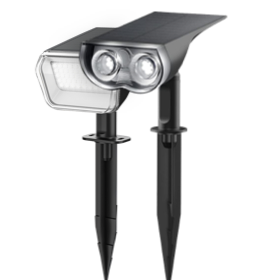Solar & LED: The Ultimate Guide to Efficient, Sustainable Lighting
In This Article:
- Why Solar & LED Are the Perfect Pair
- Key Components of a Solar-Powered LED System
- How to Choose the Right Solar Panel for LED Lights
- Step-by-Step Installation Guide
- Top 5 Benefits of Solar-LED Systems
- Common Problems & Fixes
- FAQs
As global energy costs surge by an average of 12% annually and climate urgency intensifies, homeowners and businesses are embracing solar and LED innovations to revolutionize outdoor lighting. Modern solar lights—like bright solar landscape lights and durable outdoor solar lights that work in winter—merge cutting-edge efficiency with year-round reliability. No longer limited to sunny climates, advanced systems now thrive even in partial shade. This guide unpacks how solar-LED technology delivers crisp, sustainable illumination for gardens, pathways, and commercial spaces while slashing energy bills and carbon footprints. Discover how to choose components, avoid pitfalls, and optimize performance—let’s illuminate your world smarter, brighter, and greener.

Why Solar & LED Are the Perfect Pair
The fusion of solar energy and LED lighting represents more than just a smart pairing—it’s a game-changing synergy that redefines modern energy efficiency. By combining the renewable power of sunlight with the ultra-low energy demands of LED technology, this duo delivers transformative environmental, economic, and practical benefits. Below, we break down why solar and LED are rewriting the rules of sustainable lighting.
Unmatched Energy Efficiency
Solar panels and LEDs share a natural compatibility rooted in their energy-smart design. While solar technology thrives on converting sunlight into usable power, LEDs excel at maximizing every watt of electricity they consume. Together, they eliminate waste and optimize performance.
Key Highlights:
- LEDs use 75% less energythan traditional incandescent bulbs while lasting 50,000+ hours—equivalent to over 15 years of nightly use.
- Solar panels convert 20-25% of sunlightinto electricity, making them perfectly suited to power low-wattage LED systems without straining energy reserves.
Sustainability at Its Core
This partnership isn’t just about efficiency—it’s a bold step toward decarbonizing our energy footprint. Solar-LED systems operate entirely off-grid, cutting ties with fossil fuels and reducing long-term environmental harm.
Environmental Impact:
- A typical solar-LED setup reduces CO2 emissions by 1.2 tons annually, akin to planting 50 mature trees each year.
- Zero reliance on grid powerensures no indirect contribution to coal or natural gas consumption.
Cost Savings That Speak Volumes
Beyond environmental benefits, solar-LED systems deliver tangible financial returns. With minimal maintenance and plummeting upfront costs, this technology pays for itself faster than ever.
Financial Wins:
- Most systems recoup costs in 2-3 yearsthrough energy bill savings alone.
- Government incentives, like the U.S. Federal Tax Credit, slash installation expenses by 30%, accelerating ROI.
Real-World Proof:
A California homeowner cut annual outdoor lighting costs from 240 per year to just 15 per year after switching to solar-LED—a 94% reduction in energy spending.
Key Components of a Solar-Powered LED System
A well-designed solar-LED lighting system relies on carefully selected components working in harmony to maximize efficiency, durability, and performance. Each part plays a critical role in harvesting sunlight, storing energy, and delivering reliable illumination. Below, we dissect the four essential elements that form the backbone of any solar-powered LED setup and how they contribute to its success.
Solar Panels: The Power Generators
Solar panels are the heart of the system, converting sunlight into usable electricity. The type of panel you choose impacts efficiency, space requirements, and long-term costs.
Key Types:
- Monocrystalline:Ideal for compact setups like bright solar landscape lights, offering 22-25% efficiency.
- Polycrystalline:Slightly lower efficiency (15-17%) but more budget-friendly, suited for larger installations.
- Thin-Film:Flexible for curved surfaces, perfect for integrating into outdoor solar lights that work in winter with anti-reflective coatings.
Upgrade your solar setup with the Linkind Smart Solar Spotlight SL5C—a powerhouse of innovation designed for modern, energy-conscious users. This solar spotlight doesn’t just light up your yard; it transforms it into a dynamic, customizable canvas.
Why It Shines:
- MPPT Technology: Boosts charging efficiency by 5%, ensuring reliable power even on cloudy days.
- 5C Automotive-Grade Battery: Delivers 14+ hours of uninterrupted illumination, outperforming standard lithium batteries.
- App & Voice Control: Sync with Alexa or Google Home via the AiDot app to adjust colors, schedules, or group up to 32 lights into zones.

-
Enhanced Solar Efficiency: Experience 24/7 illumination with these smart solar spotlights featuring MPPT technology that improves charging by 23.5%. Premium 5C automotive-grade technology delivers up to 14 hours of continuous solar powered spotlight performance.
-
App & Voice Control: Manage your solar landscape spotlights through the AiDot app or use voice commands with Amazon Alexa and Google Home via Linkind's Bluetooth Mesh Hub for convenient control of your solar outdoor spotlight network.
-
Dynamic Color Effects:Transform your yard with color changing solar spotlights offering 16 million color options. Create stunning light shows that sync with music—perfect for enhancing your landscape with solar spotlights for yard decoration.
-
Intelligent Scheduling: Program your solar colored spotlights with smart timers including dusk-to-dawn automation and customized schedules. Set your preferred brightness levels and timing to maximize your solar landscape spotlights' effectiveness.
-
Versatile Installation: Mount these IP67 waterproof solar outdoor spotlights on walls or ground with 360° horizontal and 180° vertical adjustability. Group up to 32 lights into 8 separate zones for comprehensive yard illumination.
Charge Controllers: The Energy Managers
Charge controllers regulate the flow of electricity from solar panels to batteries, preventing overcharging and optimizing energy storage. Choosing the right controller ensures system longevity.
Options Explained:
- PWM (Pulse Width Modulation):A cost-effective solution with 70-80% charging efficiency, best for small-scale systems.
- MPPT (Maximum Power Point Tracking):Boosts efficiency by 30% by adjusting voltage inputs, ideal for cloudy regions or variable sunlight conditions.
Batteries: The Energy Reservoirs
Batteries store solar energy for use during nighttime or low-light conditions. The choice between battery types of balances lifespan, temperature tolerance, and environmental impact.
Top Choices:
- LiFePO4 (Lithium Iron Phosphate):Delivers a 5–7-year lifespan and operates in extreme temperatures (-20°C to 60°C), offering reliability for long-term use.
- NiMH (Nickel-Metal Hydride):Eco-friendly and recyclable but shorter-lived (2-3 years), better suited for moderate climates.
LED Fixtures: The Efficient Light Source
LEDs convert stored energy into bright, long-lasting light while minimizing power consumption. Selecting the right fixtures ensures optimal brightness and ambiance.
Critical Factors:
- Lumens vs. Watts:A 10W LED producing 800 lumens replaces a 60W incandescent bulb, slashing energy use by 83%.
- Color Temperature:Choose 2700K (warm white) for cozy outdoor spaces or 5000K (daylight) for security lighting that mimics natural light.
Pro Tip: For most residential applications, a 12V system strikes the perfect balance between efficiency, affordability, and ease of installation.
How to Choose the Right Solar Panel for LED Lights
Selecting the correct solar panel for your LED lighting system is crucial to balancing efficiency, reliability, and cost. An undersized panel leaves you in the dark, while an oversized one wastes resources. By following a structured approach, you can tailor your solar setup to match your lighting needs perfectly. Here’s a step-by-step guide to making informed decisions.

Calculate Daily Energy Needs
Start by determining how much energy your LED lights consume daily. This foundational step ensures your solar panel can generate enough power to meet demand, even on suboptimal days.
Steps to Follow:
- Example Calculation:A 10W LED running 8 hours/day requires 80 watt-hours (Wh) of energy daily.
- Factor in Battery Losses:Add a 30% buffer to account for energy loss during battery storage and conversion: 80Wh × 1.3 = 104Wh daily requirement.
Determine Panel Size
Solar panel sizing depends on your location’s sunlight availability. "Peak sun hours" (hours of full sunlight equivalent) dictate how much energy a panel can produce daily.
Key Considerations:
- Basic Formula:Divide daily energy needs by peak sun hours. For regions with 4 peak sun hours/day: 104Wh ÷ 4h = 26W panel minimum.
- Climate Adjustments:In cloudy or low-light areas, upgrade to a 30W panel to compensate for reduced sunlight.
Prioritize Durability
Solar panels endure harsh weather, so durability is non-negotiable. Focus on weatherproofing and corrosion resistance to ensure long-term performance.
Must-Have Features:
- IP Rating:Choose IP65+ for panels resistant to rain, dust, and debris.
- Frame Material:Anodized aluminum frames withstand rust and corrosion, ideal for coastal or humid climates.
For pathway perfection, meet the Linkind Smart Solar Pathway Lights SP5. These aren’t just lights—they’re guardians of your garden, casting a wide 300-lumen beam to safely guide every step.
Top Features:
- 300 Lumens & Wide Angle: Illuminates twice the area of standard path lights.
- Color Temperature Control: Shift from warm white (2700K) for cozy walks to daylight (5000K) for security.
- Motion Activation: Instantly brightens when movement is detected, then dims to conserve energy.

-
Wide angle & super bright: Illuminating your world with wide-angle, super bright light of 300 lumens that will leave you in awe.
-
Multiple control modes: effortlessly manage your devices through the Aidot app or Voice control (hub required) and revel in the convenience.
-
Multicolor:Customizable color temperature and 16 million RGB options to set the perfect mood.
-
Multiple modes:Experience the best of both worlds with Sunlight and Motion modes with perfect for any mood!
-
Durable & Weatherproof: The IP65 rating showcases the product's impressive resilience against tough weather.
-
Motion activated: the light automatically turns on once motion is detected within 26 feet
-
Easy Installation: The ground insert feature adds convenience to the product's usability.
Visual Guide: Quick Sizing Reference
Use this table as a shortcut to match common LED setups with appropriately sized solar panels. These recommendations assume 4 peak sun hours and include a 30% buffer.
|
LED Wattage |
Daily Runtime |
Recommended Panel Size |
|
5W |
10 hours |
20W |
|
10W |
8 hours |
30W |
|
20W |
6 hours |
5W |
Note: Adjust panel size upward if your area averages fewer than 4 peak sun hours or experiences frequent overcast days.
Step-by-Step Installation Guide
Installing a solar-powered LED system might seem daunting, but with the right tools and methodical approach, you’ll achieve a reliable, energy-efficient setup. Proper installation ensures maximum sunlight harvesting, safe wiring, and seamless operation. Below, we break down the process into three critical stages—from mounting panels to testing the system—so you can avoid pitfalls and enjoy worry-free lighting.
Tools Needed:
Solar panels, mounting brackets, charge controller, battery, LED lights, wiring kit, multimeter.
Mount Solar Panels for Optimal Sun Exposure
Positioning your solar panels correctly is key to maximizing energy production. Focus on angle, orientation, and shading to ensure peak performance year-round.
- Angle Calculation:Tilt panels at Latitude × 0.9 + 15°. For example, at 40° latitude: 40 × 0.9 + 15 = 51° tilt.
- Avoid Shading:Place panels where trees, buildings, or obstructions won’t cast shadows, especially during peak sun hours (10 AM – 4 PM).
Simplify installation with the Linkind Outdoor Wall Lights with Motion Sensor. These sleek, weatherproof lights blend seamlessly into fences, decks, or stairways, offering hassle-free security and style.
Why Installers Love It:
- PIR Motion Sensor: Activates 27 ultra-bright LEDs within 26 feet, deterring intruders while saving energy.
- IP65 Durability: Built to withstand rain, snow, and coastal humidity.
- 3 Lighting Modes: Opt for motion-triggered alerts, dusk-to-dawn automation, or continuous glow.

-
High-efficient Solar Powered Lights: Quick-charging, long-lasting solar outdoor lights with a 22% conversion rate.
-
PIR Motion Sensor & Brightness: Motion-activated lights with 27 LEDs for wide, bright coverage.
-
IP65 Waterproof & Versatile: Durable, waterproof solar lights for fences, stairs, decks, and gardens.
-
Multiple Lighting Modes: Customizable modes for different lighting needs, including long-light and motion-detected modes.
-
Easy Installation & Warranty: Wire-free installation with included screws and reliable warranty support.
Connect Components Safely and Efficiently
A secure, well-organized wiring setup prevents energy loss and protects your system from damage. Follow this sequence to link components correctly.
- Wiring Order: Solar Panels → Charge Controller → Battery → LED Lights.
- Wire Gauge:Use 10-gauge wire for runs longer than 15 feet to minimize voltage drop and maintain efficiency.
Test the System Before Finalizing
Thorough testing ensures everything works as intended and identifies issues before they become costly problems.
- Battery Check:Use a multimeter to measure voltage. A 6V reading indicates a fully charged 12V battery.
- Automatic Activation:Verify LEDs turn on at dusk using the charge controller’s light sensor or timer settings.
Common Mistake to Avoid:
Never skip fuses—they’re your system’s first line of defense. Install a 10A fuse between the battery and charge controller to prevent overloads and short circuits.
Top 5 Benefits of Solar-LED Systems
Solar-LED systems are redefining modern lighting by merging renewable energy with ultra-efficient technology. These systems offer practical, eco-friendly solutions for homes, businesses, and remote locations. Here are the five key advantages that make them indispensable:
Off-Grid Reliability
Solar-LED systems operate independently of traditional power grids, making them perfect for remote cabins, agricultural barns, or emergency lighting. They store energy in batteries during the day, providing consistent illumination at night—even in areas with no electrical infrastructure. This autonomy ensures reliability during blackouts or in off-grid environments.
Low Maintenance
With 50,000-hour LED lifespans (over 15 years of nightly use) and solar panels requiring only twice-a-year cleaning, these systems drastically reduce upkeep. Unlike traditional bulbs, LEDs rarely fail, and solar components have no moving parts, minimizing wear and repair costs.
Weather Resilience
Built to endure extremes, high-quality solar-LED systems operate in -40°C to 85°C and withstand hurricanes, heavy rain, and dust. IP68-rated enclosures and corrosion-resistant materials ensure performance in coastal, desert, or storm-prone regions.
Scalability
Start small with a single pathway light and expand to a 10,000-lumen security network. Modular designs allow easy addition of panels, batteries, or fixtures, adapting to residential gardens, commercial properties, or municipal street lighting.
Smart Integration
Pair modern solar lights with motion sensors, Wi-Fi cameras, or voice assistants like Alexa for automated control. Programmable schedules and app-based management optimize energy use while enhancing security and convenience.
For those craving cutting-edge control, the Linkind Smart Solar Spotlight SL5 redefines outdoor lighting. Imagine syncing your garden lights to your favorite playlist or hosting a sunset party with 16 million color options—all from your phone.
Standout Features:
- Music Sync: Let your lights dance to the beat with real-time audio responsiveness.
- Group Control: Manage multiple zones effortlessly perfect for highlighting architectural features or garden paths.
- Preset Scenes: Choose from curated lighting moods like "Romantic Twilight" or "Festive Glow."

-
Group Control: The world's first solar spotlight with wireless capabilities to offer smart group control functionality.
-
Multiple Convenient App Functions: Control smart spotlights with the AiDot App. Adjust color, temperature, brightness, and use group control, music sync, and energy-saving features.
-
Music Sync & Preset Scenes: Sync RGBTW smart solar lights with music by granting microphone permission. Customize effects, preset scenes, or choose from 16 million colors to enhance your outdoor ambiance.
-
Three Optional Lighting Modes: Linkind solar lights feature 3 modes: Motion for safety and efficiency, Luminance for automatic dusk-to-dawn lighting, and Continuous for constant illumination.
-
Enhanced Lighting & Easy Installation: Linkind solar spotlights are adaptable for ground or wall mounting, with 360° horizontal and 180° vertical adjustability.
Real-World Impact:
A Texas ranch replaced 40 halogen floodlights with solar-LEDs, cutting annual energy costs by $3,200 and eliminating wiring maintenance across its vast terrain.
Common Problems & Fixes
Even the most robust solar-LED systems can encounter hiccups, but most issues have straightforward solutions. Understanding common challenges—and how to address them—ensures your setup stays efficient and reliable. Below, we break down three frequent problems, their root causes, and actionable fixes to keep your lights shining bright.
Dim LEDs at Night
When your solar-powered LEDs glow weakly after sunset, it’s often a sign of insufficient energy storage or generation.
Diagnosis & Solutions:
- Cause:An undersized battery or solar panel fails to store enough power for nighttime use.
- Fix:Upgrade to a 20Ah LiFePO4 battery for extended storage and pair it with a 50W solar panel to boost daily energy harvest.
Battery Drains Quickly
Rapid battery depletion undermines system reliability, leaving you in the dark prematurely.
Diagnosis & Solutions:
- Cause:Dirty solar panels (reducing efficiency) or a faulty charge controller (failing to regulate power).
- Fix:Clean panels monthly with a vinegar-water solution (1:1 ratio) and test the controller’s output voltage with a multimeter. Replace controllers showing inconsistent readings.
Lights Flicker
Flickering LEDs signal electrical instability, which can shorten component lifespans.
Diagnosis & Solutions:
- Cause:Loose wiring connections or voltage fluctuations from the battery or controller.
- Fix:Tighten all wire terminals and install a 12V voltage stabilizer to smooth out power delivery to the LEDs.
Pro Tip: Invest in a solar charge tester (around $25) to quickly diagnose panel output and battery health. Regular checks help catch issues before they escalate.
Conclusion
Solar-LED systems stand at the forefront of sustainable innovation, offering a powerful blend of energy efficiency, cost savings, and environmental stewardship. By harnessing sunlight and pairing it with ultra-efficient LED technology, these systems provide reliable, off-grid illumination while slashing energy bills and carbon footprints. Whether for homes, businesses, or remote locations, the benefits—from weather resilience to smart integration—make solar-LED lighting a future-proof investment. Embrace this transformative solution today, and light the way toward a brighter, greener tomorrow.
FAQs
Q: Can solar panels charge LED lights in winter?
A: Yes but expect 20–40% reduced output. Use panels with anti-reflective coatings for better low-light performance.
Q: How long do LED lights last in solar systems?
A: High-quality LEDs last 10–15 years (50,000+ hours), even with daily use.
Q: Do solar-LED systems work in shaded areas?
A: Partial shading cuts efficiency by 50%. Install panels in direct sunlight for optimal results.
Q: Are lithium batteries worth the extra cost?
A: Absolutely. LiFePO4 batteries outlast NiMH by 2–3x and perform better in extreme temperatures.
Q: Can I connect a solar panel directly to an LED?
A: No—you need a charge controller and battery to regulate energy flow and store power.






































